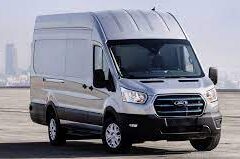Continuing steps to move to a more battery-powered delivery fleet, the Postal Service announced on February 28 that, “after a competitive search,” it had awarded a contract to Ford Motor Company for 9,250 Ford E-Transit Battery Electric Vehicles.
However, the agency conditioned starting delivery of the trucks, planned for December, on the “successful completion of the Supplemental Environmental Impact Statement that we announced we would undertake in August 2022, and the related issuance of our Record of Decision pursuant to the National Environmental Policy Act.”
The Ford E-Transit BEVs, to be manufactured in Kansas City (MO), are part of the 21,000 commercial off-the-shelf vehicles included in the Postal Service’s vehicle acquisition plan announced in December 2022.
The USPS also announced it will buy another 9,250 left-hand drive internal combustion engine vehicles “to fill the urgent need for vehicles.” The award for those trucks went to Fiat Chrysler, and deliveries should begin in November.
The total cost for the 18,500 trucks is just over $1 billion.
Charging
The USPS announcement also included an award to three suppliers for 14,000 charging stations and “an initial and ongoing Electric Vehicle Supply Equipment (EVSE) inventory. This EVSE inventory is the charging station hardware and software needed to support EV charging at the facilities from which the delivery vehicles will operate.”
The awarded contracts, valued at $260 million, went to Blink Charging Co., Siemens Industry Inc., and Rexel USA Energy Solutions, the Postal Service stated. According to Federal News Network, “USPS expects to order, at a maximum, 41,500 charging stations under its Indefinite Delivery Indefinite Quantity (IDIQ) contracts with three vendors.”
However, the agency was not specific about where the electric vehicles will be assigned or where the charging infrastructure would be installed: “The specific locations for deployment of the vehicles and infrastructure have not yet been finalized and will depend on route characteristics, including whether a left-hand drive vehicle is mission-suitable as well as other business considerations. The Postal Service plans to begin building out its charging infrastructure
across a minimum of 75 locations within the next 12 months, and thereafter to continue the infrastructure build out in the succeeding years at many additional facilities as a part of our delivery vehicle electrification strategy.”
Nonetheless, some reports of the awards claimed that a portion of the charging stations would be installed at the new sorting and delivery centers, starting in the third quarter of this year (April-June).
Taking credit
As would be expected, the Postal Service used the announcement of the awards to further praise its vehicle electrification initiatives, but its record of interest in EVs shows its enthusiasm was not self-initiated.
When, after years of development and bidding, the USPS awarded a contract for the replacement of its current and obsolete fleet of Long Life Vehicles to Oshkosh Defense, only 10% of the initial order was for battery-powered vehicles. The USPS and the Postmaster General quickly came under criticism for failing to require a higher percentage of the “Next Generation Delivery Vehicle” units be electrically-powered, resulting in multiple lawsuits that accused the agency of errors in its environmental impact statement.
Realizing that he was in a politically unpopular position, the PMG quickly pivoted to a revised vehicle strategy, increasing the EV order with Oshkosh from 10,000 units to 25,000, and deciding that future orders would be primarily for EVs, setting the target acquisition at 66,000 vehicles. The NGDVs ordered from Oshkosh and the COTS trucks ordered from Ford total 34,250 EVs, a little over half of the target figure.
Last December, the USPS stated it would “sharply increase the number of electric-powered delivery trucks” it will order in the future and that, starting in 2026, all new trucks ordered would be electric.
Federal News Network noted that “in total, the agency expects to purchase 100,000 electric and gas-powered delivery vehicles through 2028.” That would put the USPS “well ahead” of federal “green government goals.” (In December 2021, the president had signed an executive order requiring all federal agencies to purchase 100% zero-emission vehicles by 2035, and purchase only zero-emission light-duty vehicles starting in 2027.)
According to the Postal Service, its total investment in vehicles is expected to reach $9.6 billion, paid in part by $3 billion from Inflation Reduction Act funds.
Up North
Meanwhile, Canada Post has already begun deploying its own electric delivery vehicles. On March 1, the agency rolled out the first 14 battery-electric vehicles of what it states will be a fleet of 14,000 EVs by 2040. According to Canada Post, the site, at Nanaimo on Vancouver Island (BC), was chosen “partly because of the clean energy BC offers through its hydroelectric network.” The post has set aside more than C$1 billion for measures to “cut emissions and move forward on the electrification of its last-mile fleet.”


